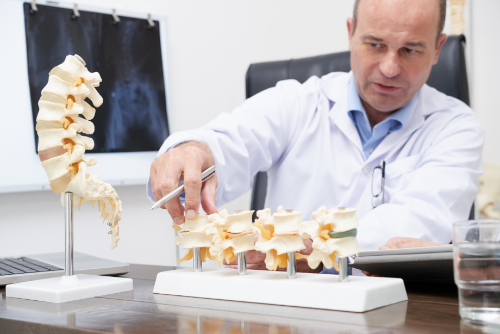
Degenerative disc disease is a condition where the degradation of your spinal discs leads to pain and discomfort. Everyone’s discs wear down over time, but not every person experiences pain due to this process.
What are the 4 Stages of Degenerative Disc Disease
Two of the main components of the spine are the vertebrae and the discs. The discs sit between vertebrae to provide cushion, support and flexibility. Each disc is made up of a soft inner layer and tough outer layer. Over time, or due to injury, the discs can lose their integrity, begin to thin and even tear in certain cases. Compromised discs increase the likelihood of pressure on nerves and friction between the vertebrae.
Like many diseases, degenerative disc disease has several possible stages. As the stages progress, the negative symptoms become more pronounced.
Stage 1
The first stage of degenerative disc disease may go unnoticed by the individual but can be identified by a chiropractor or other medical professional. The loss of the natural curvature of the spine can indicate the beginning of degenerative disc disease. Pain may not be apparent, but extra pressure is being placed on the spine which can lead to more rapid aging of the spine, nerves, joints, etc.
Stage 2
The degradation of discs becomes more apparent in the second stage. They may look thinner, and it is common to see deformations in the bone, such as bone spurs. The curvature of the spine will become more unnatural and the spinal canal may become more narrow. Stage 2 is often where you will begin to notice some pain and discomfort.
Stage 3
Stage 3 is marked by a more extreme change in the posture and curvature of the spine, along with more pain and loss of mobility. Nerve damage is common and scar tissue typically begins to form. Discs are even thinner than before, which can sometimes cause even more deformation of the bones.
Stage 4
The final stage of degenerative disc disease is the most severe and is typically considered irreversible. Discs are at their thinnest or gone altogether. The flexibility of the spine is extremely limited and pain is often considerable. Nerve damage can be severe and the bones of the spine may even begin to fuse together.
What Can Chiropractic Do for Degenerative Disc Disease?
Chiropractic care is a preferred treatment option for degenerative disc disease for a variety of reasons. Because it is gentle and non-invasive, chiropractic is much less likely to create undesirable side effects—which are common with prescription medications and surgery. Obviously, the earlier the stage of degenerative disc disease, the more successful treatment can be. But chiropractic can be helpful even in the most extreme cases of degenerative disc disease.
Chiropractic treatments may include:
Chiropractic Adjustments
One of the most effective ways to treat degenerative disc disease is to ensure the spine is in proper alignment. Loss of alignment, which can happen due to injury or just day to day life, puts extra stress on the spine which can accelerate the degradation of discs. Adjustments bring back alignment.
Spinal Decompression
Spinal decompression uses gentle but firm pressure to bring space back between the vertebrae. Space allows blood flow to return and healing to happen. Decompression is an important treatment to complement adjustments.
Now is the Time to Treat Degenerative Disc Disease
The best time to seek treatment for your back and neck pain is right now. Our chiropractic team can help you feel better and live a healthier life. Please contact us now to learn more!